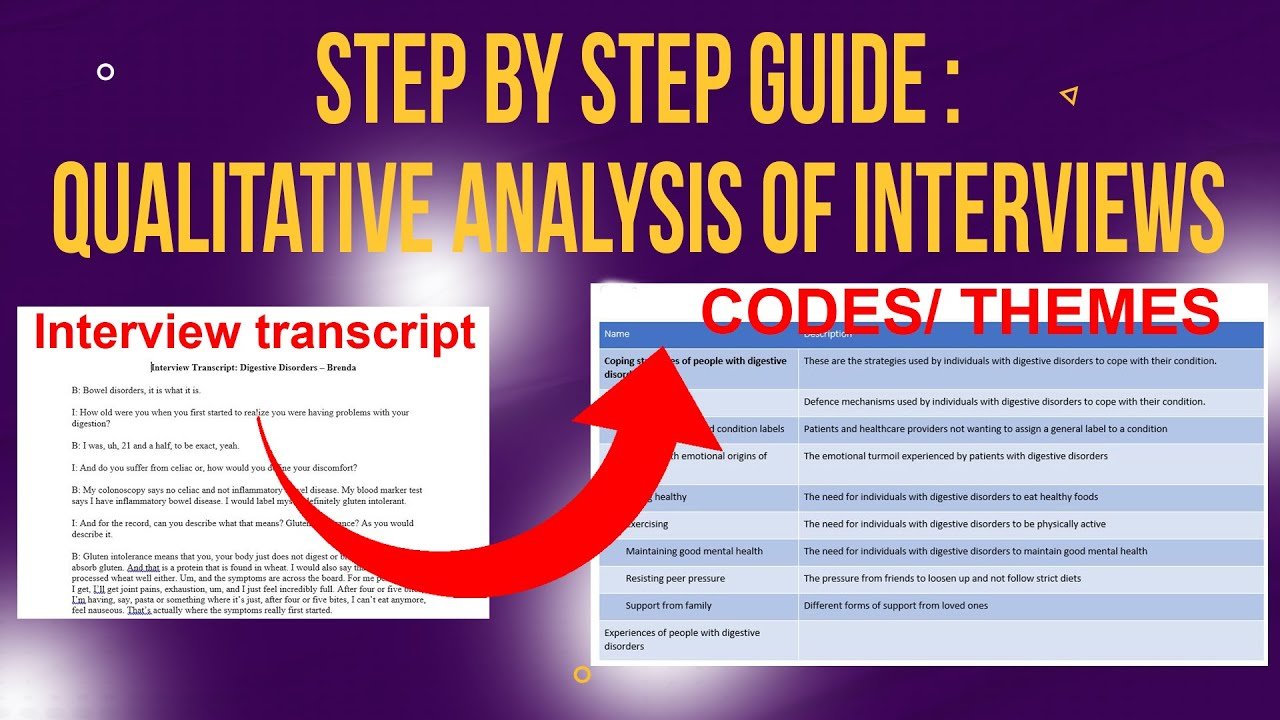Qualitative coding and Examples
One of the most important skills that we have to master when we want to analyze qualitative data is generating qualitative codes or what we call coding in qualitative analysis.
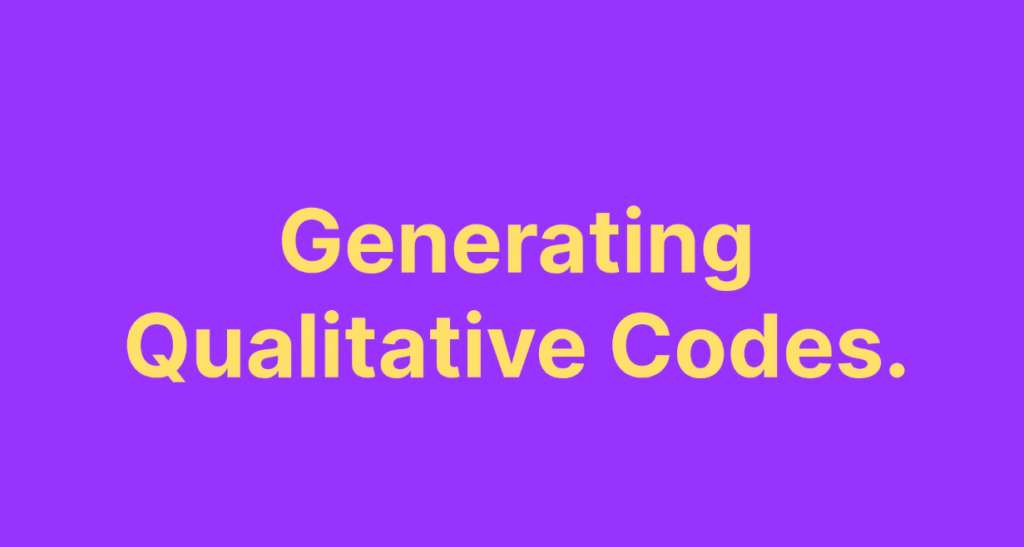
Coding is the process of tagging important quotes from your original data and interpreting such data in a way that we can combine those codes to form themes in a later stage.
In this article, I will simply be teaching you how to perform qualitative coding using N-Vivo, which is one of the most popular qualitative data analysis soft-wares.

Now I’ll begin this article by showing an example of some codes I generated in one of my previous articles.
Remember I get all these transcripts from a website called fig-share.
You can see in the comments I was coding manually.
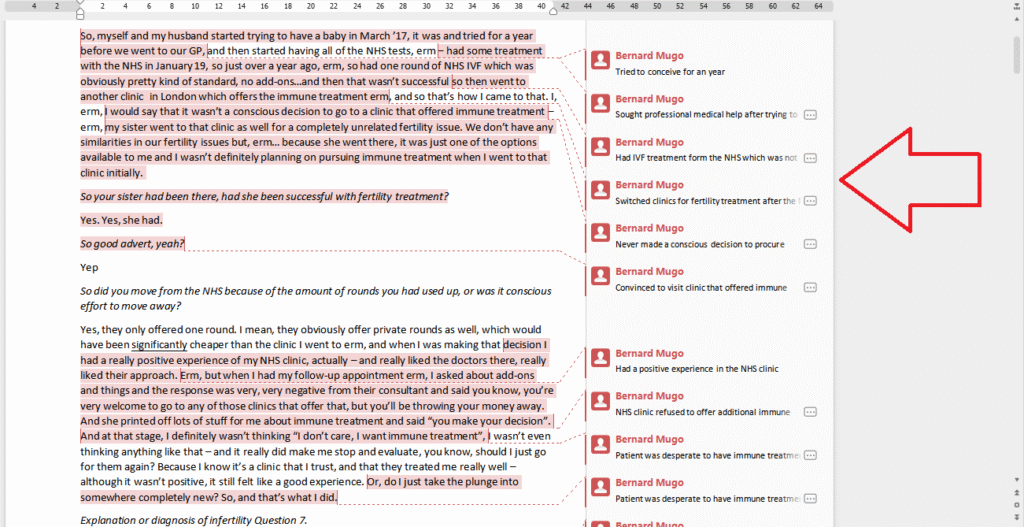
We can code manually or we can code in-Vivo.
But before we introduce in-vivo, let’s just read some codes I had generated.
This was a transcript about experiences of women with immune treatments for fertility.
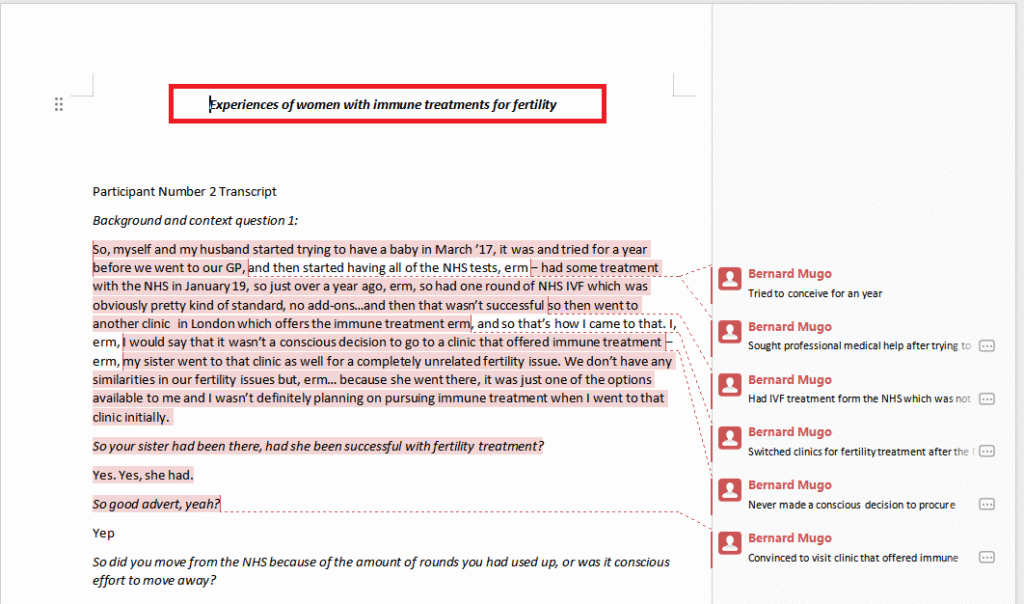
Let me read this paragraph and see the codes I generated.
So myself and my husband started trying to have a baby in March 17th, it was and tried for a year before we went to our GP and then started having all of the NHS tests.
Has some treatment with NHS in January 19 so just over a year ago.
So had one round of N-H-S I-V-F, which was obviously pretty kind of standard, no adults, and then that wasn’t successful, so then went to another clinic in London, which of has immune treatment. And so that’s how I came to that. I would say that it wasn’t a conscious decision to go to a clinic that offered immune treatment.
My sister went to that clinic as well for a completely unrelated fertility issue. We don’t have any similarities in our fertility issues, but because she went there, it was just one of the options available to me and I wasn’t definitely planning on pursuing immune treatment when I went to that clinic initially.

let’s see the codes that we have for that.
The first one is, so myself and my husband started trying to have a baby in March 17, and I tried for a year before we went to our GP.
so tried to conceive for a year is the code.
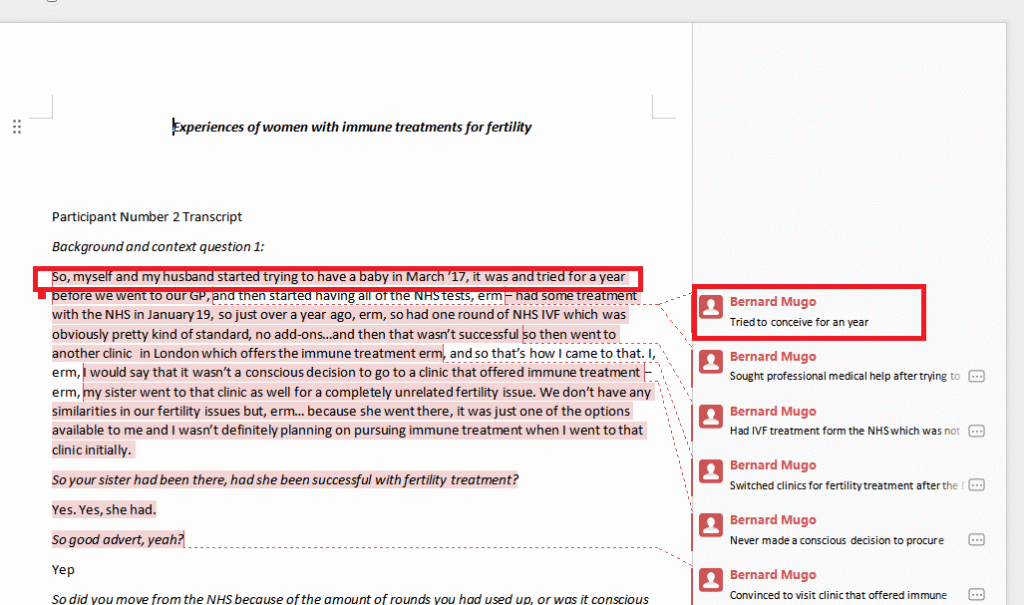
That’s the code that I attached to this statement.
Another code that I had was, then went to another clinic in London which offers immune treatment.
so my code was switched clinics for fertility treatment.

You can see I’m trying to interpret what this person is saying, that is what coding is about. I’m generally tagging important codes with either short labels or interpreting segments that are important to the original objective of this researcher.
That’s just an example
Coming up with Codes in N-Vivo
I would like us to do some coding together in N-Vivo.
So the first thing that I’m going to do is to open N-Vivo.
Right now I am using N-Vivo 15 which is the latest version in 2025.
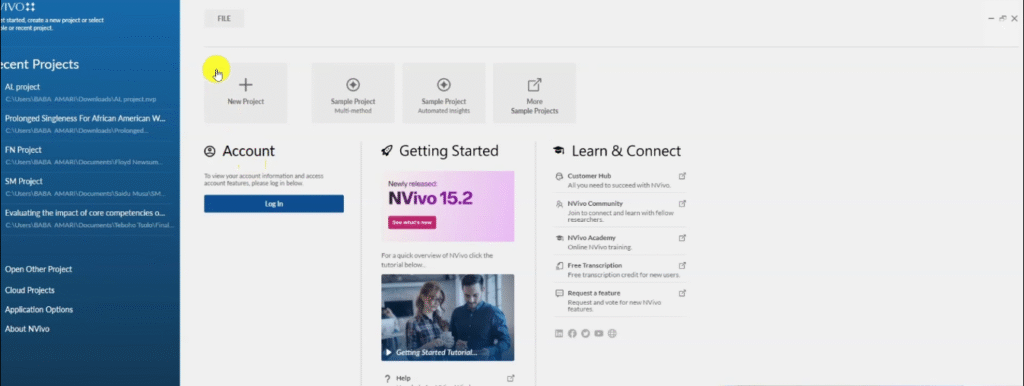
Probably there will be other versions in the future, but the basics of coding are still the same.
The study title for this tutorial is opinions of physiotherapist at the university teaching hospital on assessing psychological well-being of patients with stroke.

And I have three transcripts that we are going to do some coding in.
When you open N-Vivo the first thing that you see is this welcoming menu.
When you click on new projects we can name our project, I want to call this just a random name “Qual coding projects”.

You can name it the way you want.
Then create project, of course we do not want to save, we displace reminder every 15 minutes then we create the project.
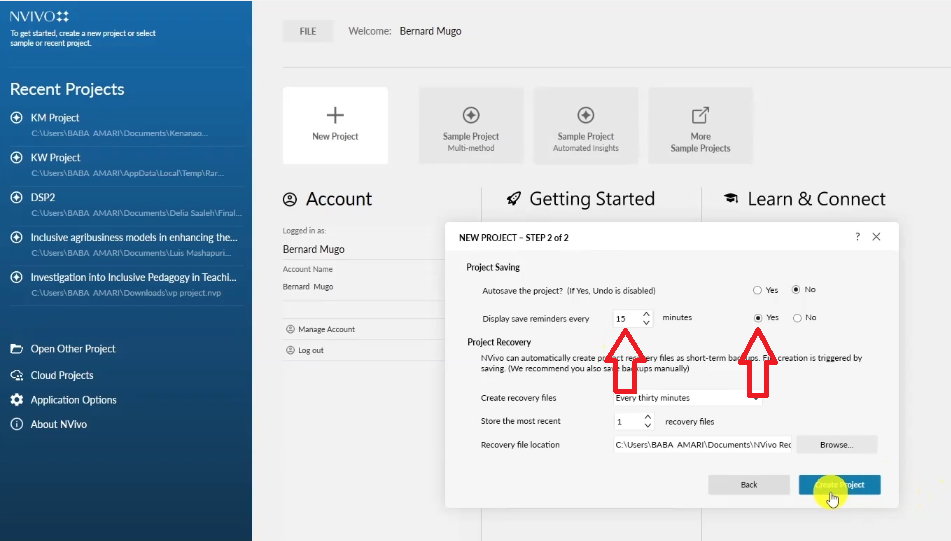
In N-Vivo, when conducting thematic analysis we only use the basic menus files and codes.
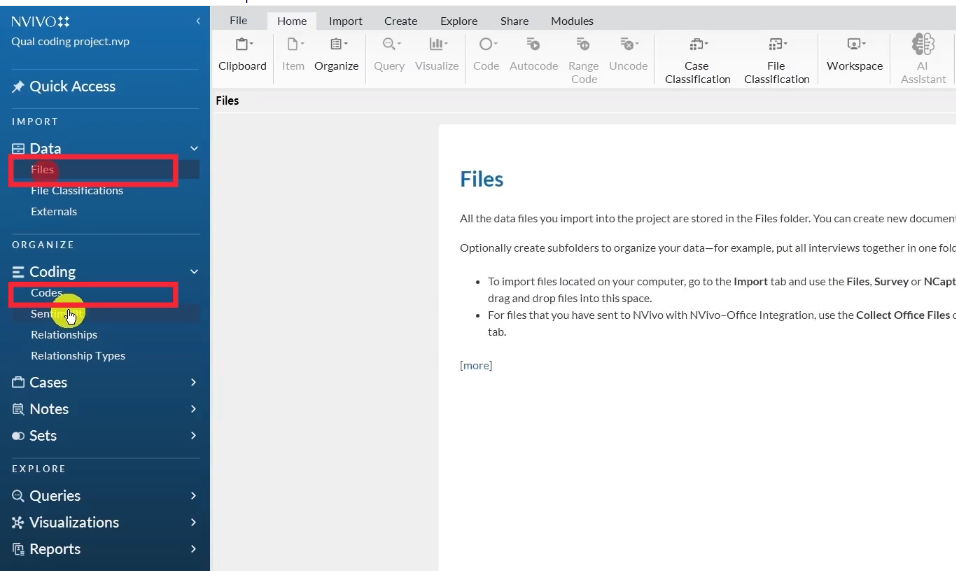
To upload the transcripts go to files then drag and drop the transcripts in the files section.

That is one way of importing.
Another way of importing is going to import.

Then going to files then finding our files.

And then importing our files in there.
That’s another way of importing.
So how do we do coding?
The first thing that I like to do is be organized.
So in the code section, I like to create a folder called initial codes.

It’s not a must, but I like tracking my work because we are doing initial coding.
Then later we should go and combine codes based on shared meaning to form themes.
I go and open one of my transcripts by double clicking on it and then we start coding.

Now to code what do we need to do?
We need to understand the main issue that we wanna analyze.
Here we’re looking at opinions of physiotherapists at a university teaching hospital on assessing the psychological wellbeing of patients with stroke.

Ideally these interviews are about the psychological helpings of patients with stroke.
So interviewer, I would like to try to find out what sorts of ideas that come to you when you think about people with mental health problems, like how might they communicate?
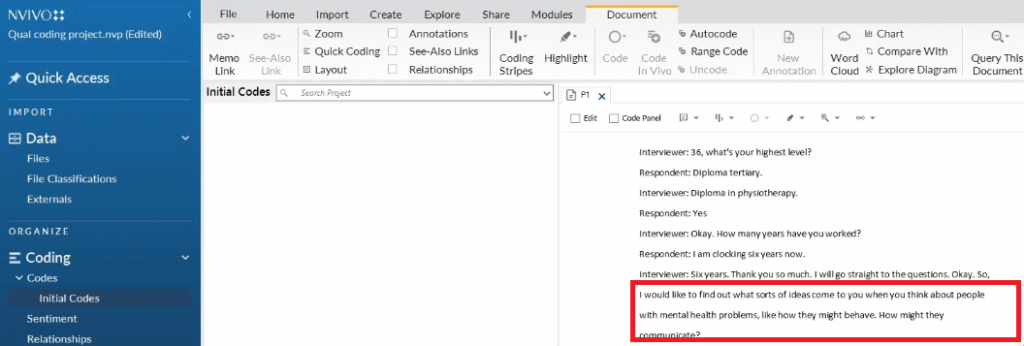
The question will help us a lot in knowing how to code because we are trying to interpret the responses.
Those are what we call codes.
And in some instances I like using either color codes or to think of the questions as containers.
Let me show you what I mean.
If you go to the original question and start marking questions with a certain color so as to know where they come from.
For example I can tag that question as red.
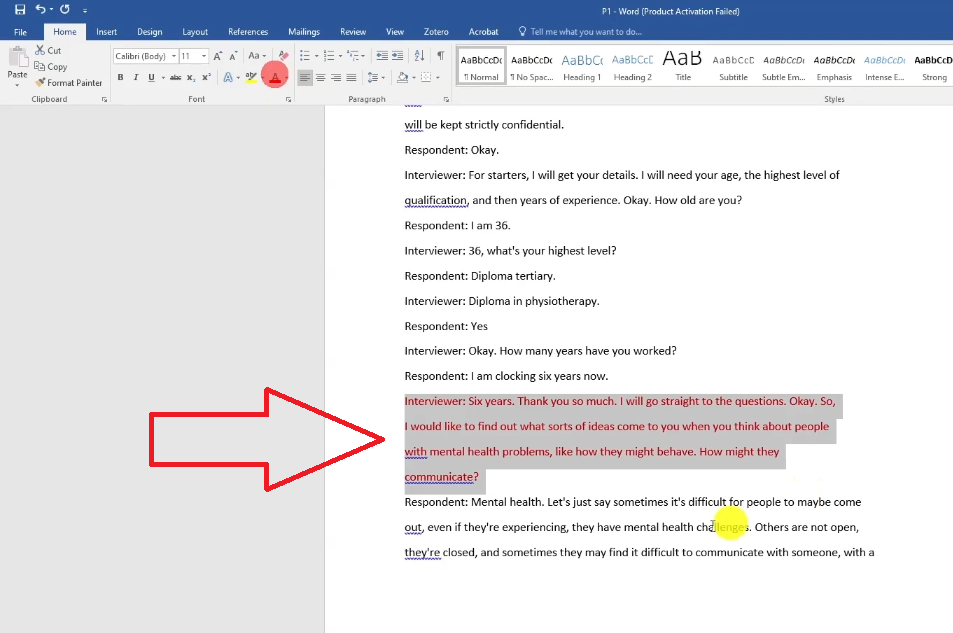
Then I can tag this other with green.

Then I can tag these other with blue and so on and so forth.
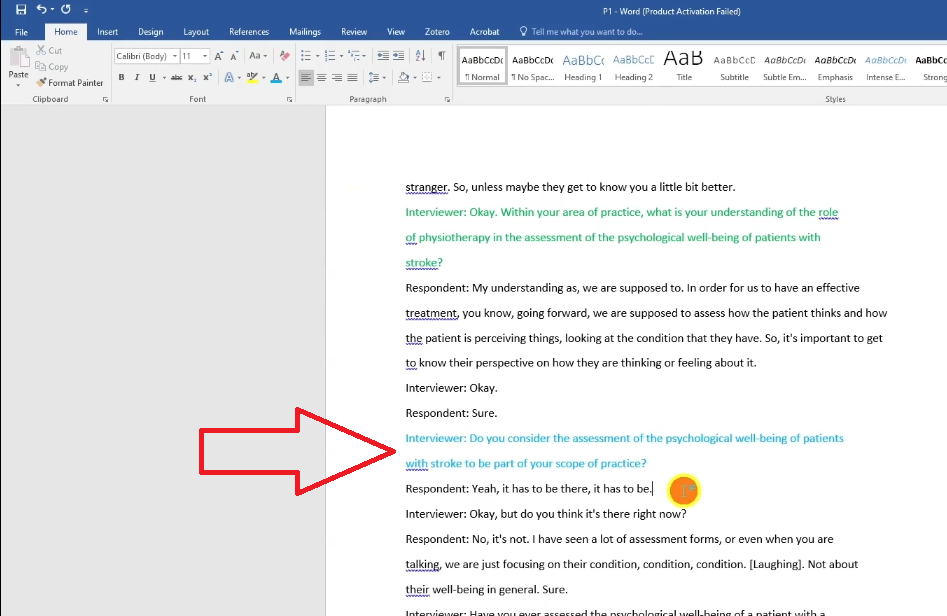
Let’s go and do the coding now and then tag those codes with that color.
Sometimes when you are coding it’s good to read the whole paragraph before you begin generating codes.
It’s difficult for people to maybe come out even if they’re experiencing they have mental health challenges others are not open they are closed and sometimes they may find it difficult to communicate with someone and with a stranger so unless maybe they get to know you a little better.

The question remember was What sorts of ideas come to you when you think about people with mental health problems, like how they might behave how they might communicate?

This response says that Patients might find it difficult to seek help when they have mental health issues highlight that.
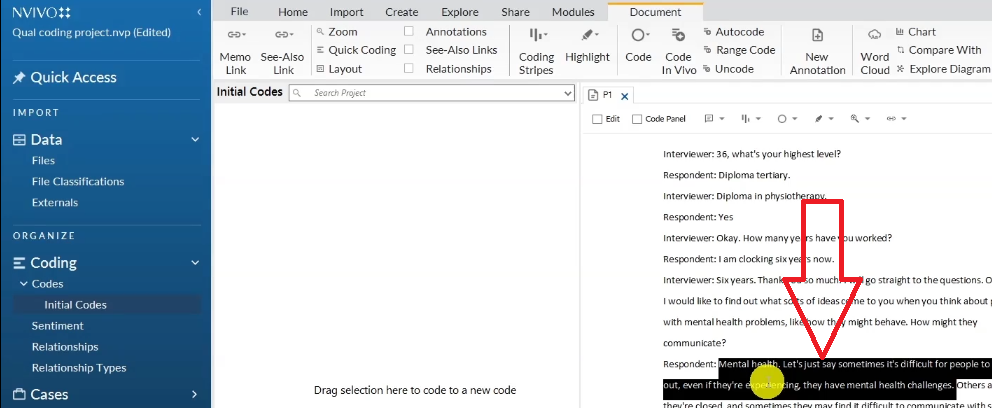
Right click select code selection.
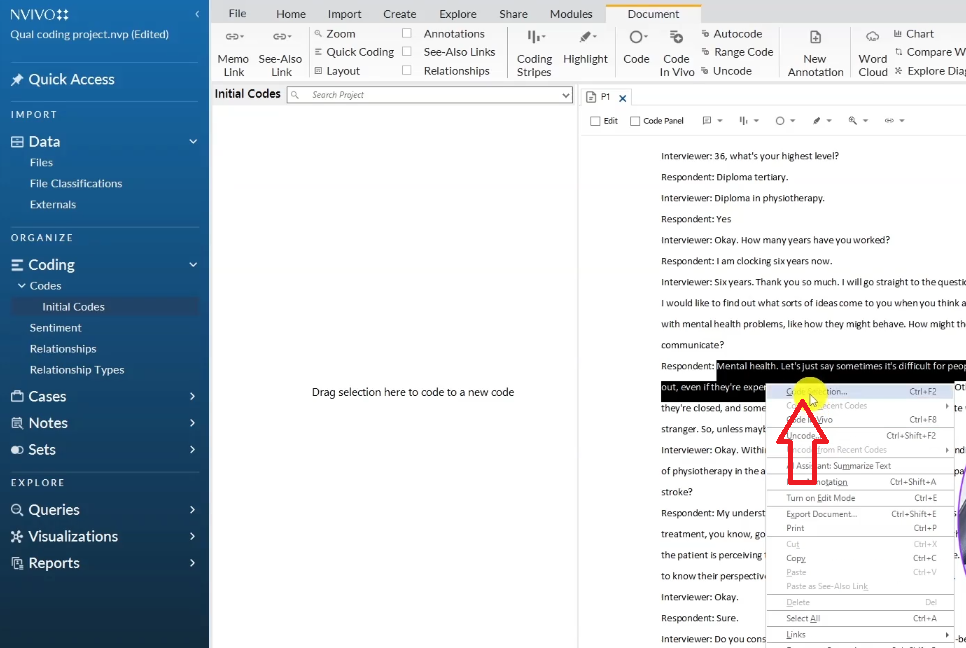
Go to initial codes then top level codes.
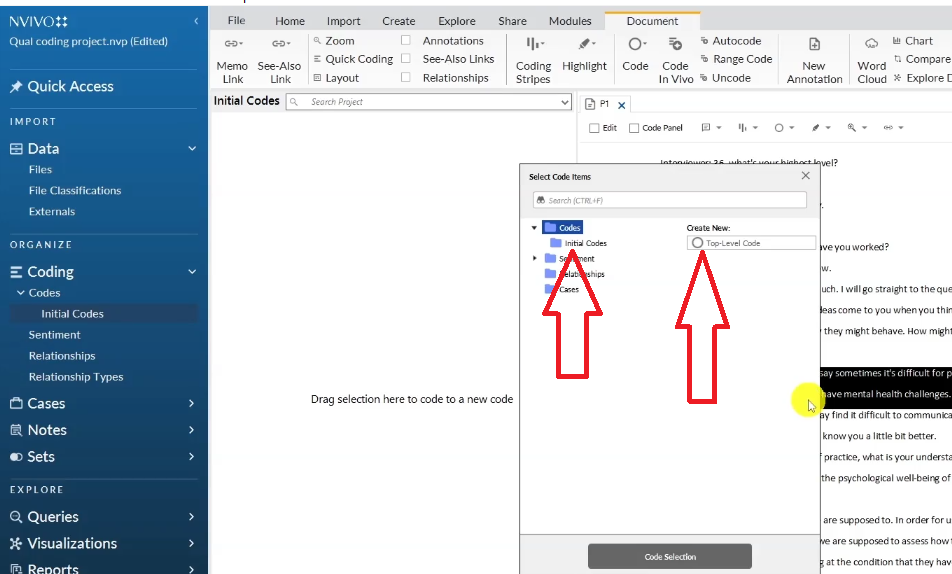
Then say individuals with mental health issues might find it difficult to seek for help.

That’s my first code it is so long.
Sometimes codes can be long or they can be very concise.
But I don’t over obsess on making codes be concise at the first time because we can always come and revise them.
Then others are not open they are closed and sometimes they may find it difficult to communicate with someone.
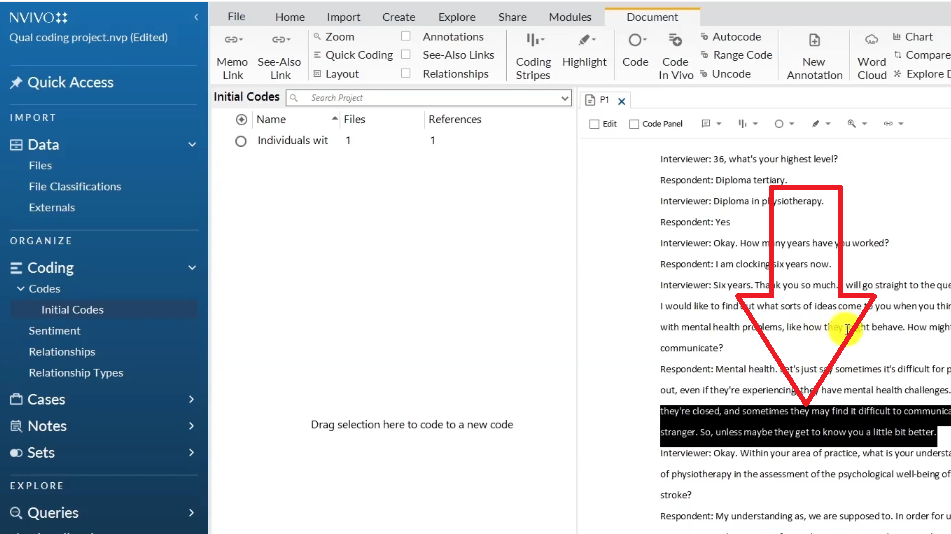
The question was how they might behave, how they might communicate.
So difficulties communicating.

Because this person is simply saying people in mental health might find it difficult to communicate.
Remember to color code the codes.
I right click then go to color you can mark red.

And another one here you can see we mark it as red.

We want to know where they came from originally.
Let me go back to the transcript and get more quotes.
Do you consider the assessment of psychological well-being of patients with stroke to be part of your scope of practice?
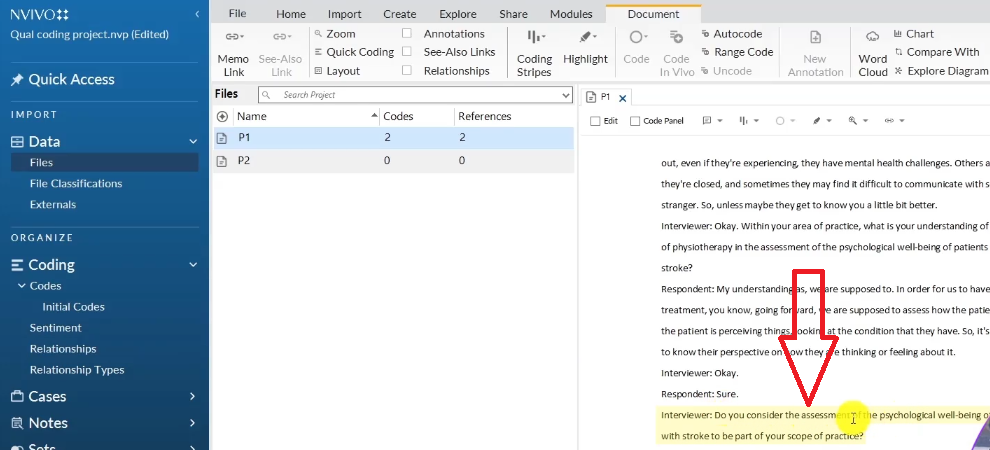
Yes it has to be there it has to be.
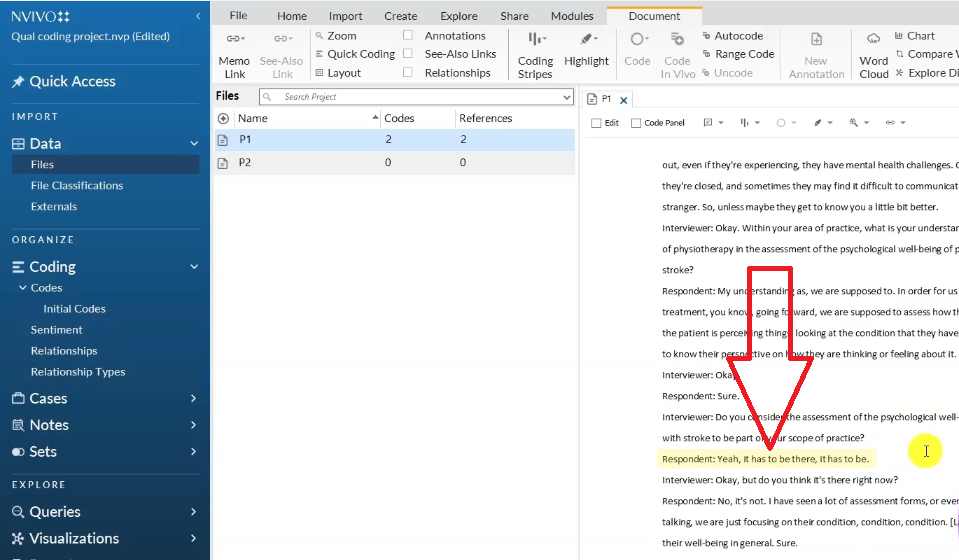
So this person considers the assessment of psychological wellbeing of patients with stroke to be part of their scope of practice let me code that.
Right click.
Go to code selection.
Then say considers assessment of psychological being as part of scope of practice.

That is another code for another question and probably if you remembermy original transcript the color for that is green.
But you do think it’s there right now.

Then this person says no it’s not I have seen a lot of assessment forms or even when you are talking we are just focusing on their condition, condition, condition, not about their well-being in general.

Let me code that section as psychological well-being assessment is not currently provided to stroke patients.

That’s what that person is saying that they have not seen stroke patients receiving any form of psychological wellbeing treatment currently.
And basically this is how we generate codes.
There are ways of remaining organized throughout the whole coding process which I have covered in other articles I’m going to link below but generally for this article we want to just get the codes.
That is for the first transcript, if I click on this highlight button and click on all coding you can see the areas I’m coding .

We only code sections that are important to our research objectives and we never code sections that we think are not being important to our research questions.
Basically that’s how we know what to code and what not code in these transcripts.
So if I click on the second participant and do the same coding for the first section, I’ll proceed with the interview.
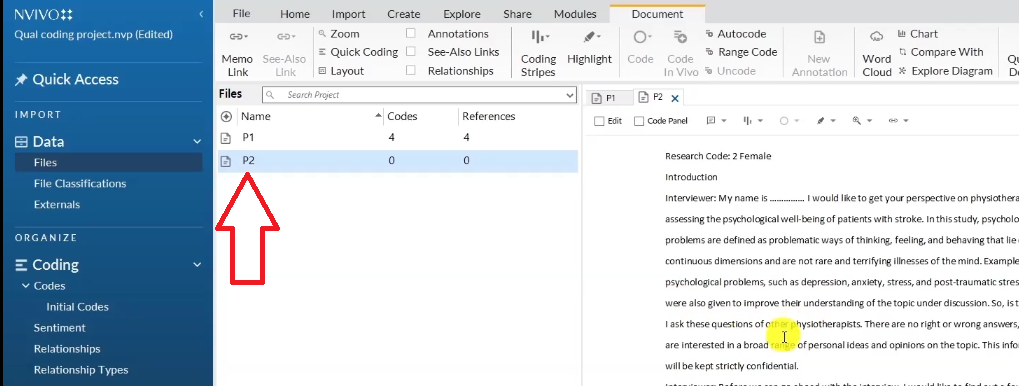
I want to find out what sorts of ideas come to you when you think about people with mental health problems, how they might behave and how they might communicate.

The thing is most of them have some are moody, they have got communication difficulties and some can’t even answer you when you ask something.
So being moody is one code.
We highlight, we got to initial codes, top level codes, Being moody.

So being moody is another code and then remember that’s related to the first question in the first transcript if you remember the color code for that is red.

I want to mark being moody as red.

Why should we mark the codes like this?
Because we want to know where they came from later because we are going to combine the codes together to form themes.
Let’s keep going.
They have got communication difficulties.

Remember we had a code from the other transcript where the person talked about difficulties in communication.
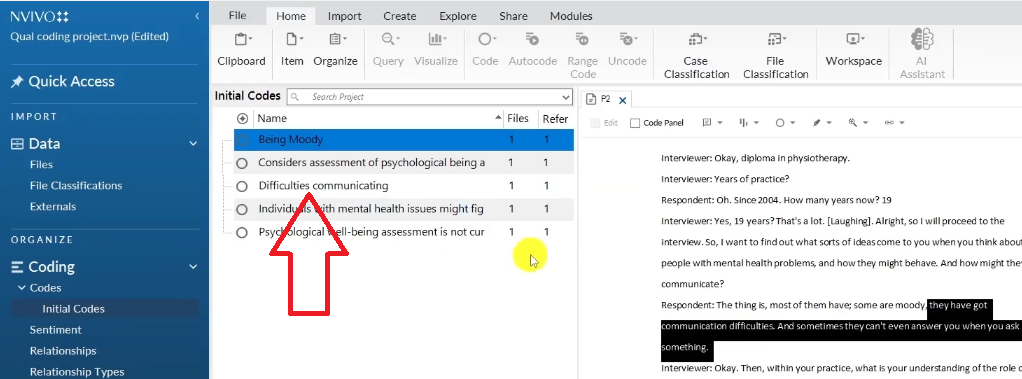
This is why we use N-Vivo to conduct coding.
So when we have quotes from two different participants that talk about the same thing, we simply highlight drag and drop the quote inside the code.
See the numbers are one file and one reference.

So drag and drop the quote to the code and the numbers will change to two files and two references.

If you double click on this, you will see that there are two quotes that are interpreted through the same code and that explains why we have two files and two references.
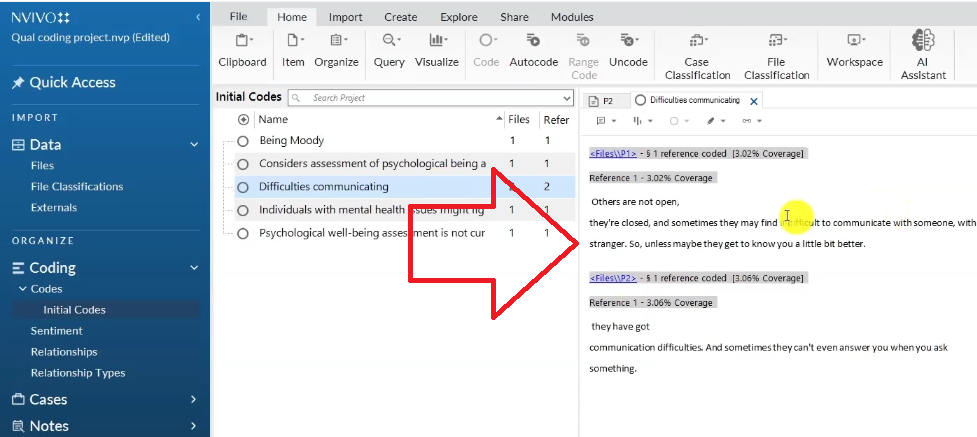
Then within your practice what is your understanding of the role of physiotherapies in assessment of psychological well-being of patients in stroke?
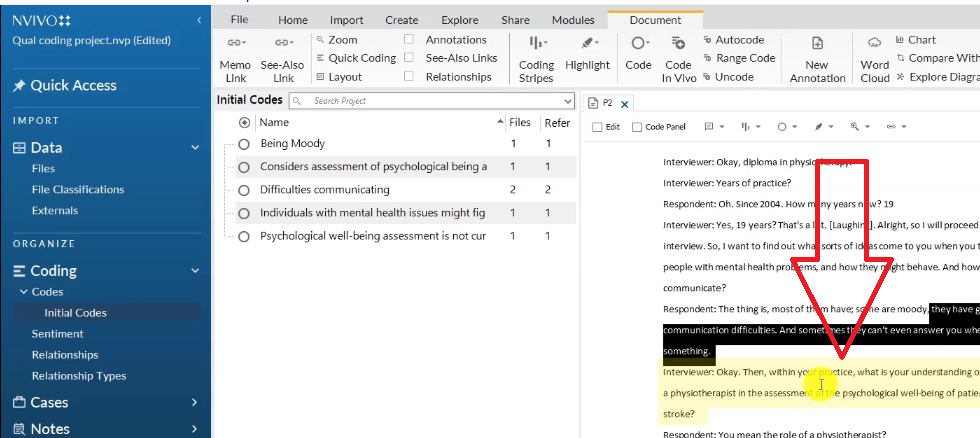
You mean the role of physiotherapist?
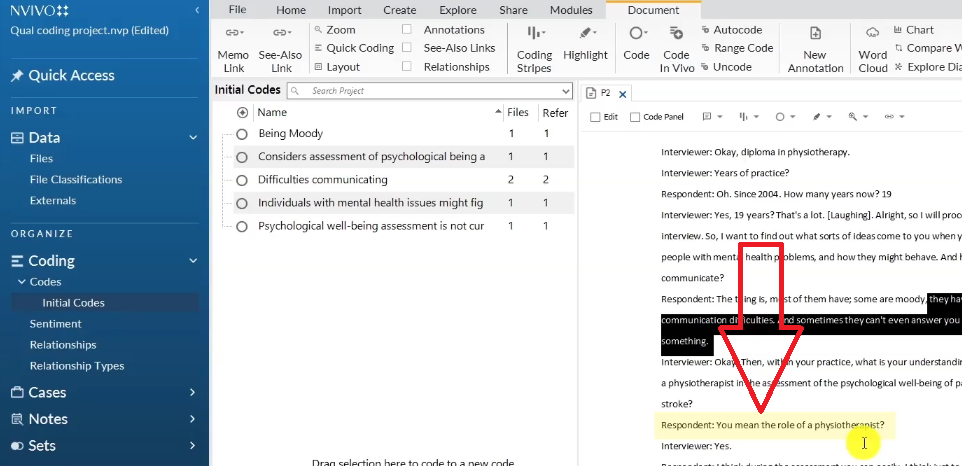
I think during assessment you can easily just to identify most of the time we don’t help much counseling patients just we don’t have the knowledge yet, but we can easily identify that the patient’s needs psychological evaluation .
So this person is saying the physiotherapy can assess whether stroke patients need psychological evaluation.
Let me code that directly.
Physiotherapists can determine whether stroke patients need psychological evaluation.

That’s another code generally that’s how we code.
As we are coding you can see the files and the references are being tabulated by N-Vivo.
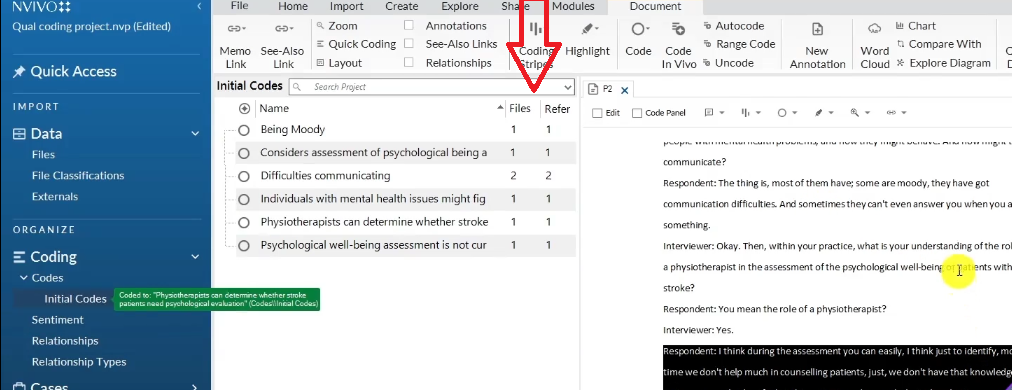
That means N-Vivo tracks down everything we are coding and also captures the quotes.
So these are the quotes that we will use to support our findings report.
Another thing is if you look at these two participants you can see N-Vivo is also counting the codes.
If we could have done the whole transcript probably we could have 50 codes.
But in this article I just wanted to introduce you to coding and give you some tips.
The main thing that we should consider when we are coding is to have an objective mind and to only code sections that are important to our research objectives and to make sure that our codes are interpretive.
We are not summarizing, we are coding, we are tagging information with concise labels we have to combine the labels later which are referred to as codes based on shared meaning to form themes.
Basically that’s how qualitative coding is done.
remember that we code transcript by transcript, once you start going transcript by transcript, you start getting more codes.
We do not code just a section.
This is how we can perform qualitative coding using N-Vivo.
